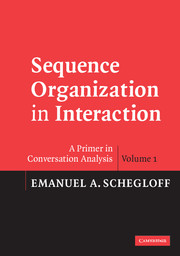Book contents
- Frontmatter
- Contents
- Preface
- Acknowledgments
- 1 Introduction to sequence organization
- 2 The adjacency pair as the unit for sequence construction
- 3 Minimal, two-turn adjacency pair sequences
- 4 Pre-expansion
- 5 The organization of preference/dispreference
- 6 Insert expansion
- 7 Post-expansion
- 8 Topic-proffering sequences: a distinctive adjacency pair sequence structure
- 9 Sequence-closing sequences
- 10 Sequences of sequences
- 11 Retro-sequences
- 12 Some variations in sequence organization
- 13 Sequence as practice
- 14 Summary and Applications
- Appendix 1 Conversation-analytic transcript symbols
- Appendix 2 Transcript of a telephone call
- References
- Index
8 - Topic-proffering sequences: a distinctive adjacency pair sequence structure
Published online by Cambridge University Press: 05 September 2012
- Frontmatter
- Contents
- Preface
- Acknowledgments
- 1 Introduction to sequence organization
- 2 The adjacency pair as the unit for sequence construction
- 3 Minimal, two-turn adjacency pair sequences
- 4 Pre-expansion
- 5 The organization of preference/dispreference
- 6 Insert expansion
- 7 Post-expansion
- 8 Topic-proffering sequences: a distinctive adjacency pair sequence structure
- 9 Sequence-closing sequences
- 10 Sequences of sequences
- 11 Retro-sequences
- 12 Some variations in sequence organization
- 13 Sequence as practice
- 14 Summary and Applications
- Appendix 1 Conversation-analytic transcript symbols
- Appendix 2 Transcript of a telephone call
- References
- Index
Summary
The post-expansions discussed so far are ones that have developed in a sequential environment in which (as noted early on) preferred responses are sequence-closure-relevant and dispreferred responses are sequence-expansion-relevant. With the exception of minimal post-expansions and simple repair sequences, the post-expansions we have examined are generally implicated in disagreement and misalignment.
It is possible, however, to have a sequential environment in which there is a systematic reversal of the ordinary differential expansion relevance of preferred and dispreferred second pair parts. Specifically, in topic-proffering sequences, as we will see, preferred responses engender expansion and dispreferred responses engender sequence closure. In this distinct sequence type, expansion has a very different interactional import, and poses sequential problems of a different character, so much so that the development and extension of these sequences can not be assimilated to what we have been referring to as post-expansion.
We have already had occasion to register the fact that some turn types may do “double duty,” both enacting their own action (questioning, assessing, telling) and serving thereby as the vehicle or instrument for another action. The same utterance (or, more technically, TCU) which does questioning can be doing requesting, or offering, etc. The same utterance which does telling can, by what is told or how, constitute a complaint. The TCU which conveys an assessment can thereby accomplish a compliment or an insult.
Information
- Type
- Chapter
- Information
- Sequence Organization in InteractionA Primer in Conversation Analysis, pp. 169 - 180Publisher: Cambridge University PressPrint publication year: 2007
